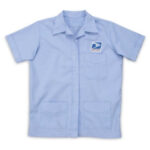The American Army uniform during World War II was a study in practicality and adaptability, designed to equip soldiers for diverse combat environments. Understanding the nuances of the Wwii American Army Uniform reveals critical aspects of military history and material science of the era. This article delves into the key uniform components worn by US soldiers in both the European and Pacific theaters of operation, highlighting the variations tailored to different climates and combat needs.
European Theater of Operations Uniforms
The uniforms for the European Theater of Operations (ETO) were primarily designed for colder, temperate climates. Durability and protection from the elements were paramount.
Field Jackets: M-1941 and M-1943
The field jacket was a crucial piece of outerwear for American soldiers in Europe. Two main versions were prevalent: the M-1941 and the improved M-1943. The M-1943 Field Jacket, pictured below, was a significant upgrade. Adopted to replace the earlier M-1941, this jacket was crafted from darker olive drab cotton-poplin. It featured a single-breasted design with concealed buttons for better weather resistance. Key improvements included the addition of two interior pockets, a detachable hood for varied weather conditions, a cotton-poplin liner for added warmth, and an internal drawstring to adjust the fit and retain body heat more effectively. The M-1943 was notably more wind-resistant and water-resistant compared to its predecessor.
The M-1941 Field Jacket, while phased out by the M-1943, was also a common sight in the early years of the war. This windbreaker-style jacket was made from olive drab cotton-poplin and lined with warm wool flannel. It featured a zipper closure, a roll collar, buttoned cuffs, and slanted front pockets. Its looser fit and economical design made it a practical replacement for the heavier service coat in field conditions.
Overcoats
For extreme cold weather conditions, the overcoat was an essential part of the wwii american army uniform. Constructed from thick wool melton fabric, these overcoats provided substantial warmth and protection against harsh winter climates encountered in Europe.
Service Shirts
Worn as a standard base layer, service shirts were button-up style garments made from olive drab wool flannel. These shirts featured two functional breast pockets and cuffs that could be secured with buttons. The collar was designed to accommodate a necktie, reflecting the formal aspects still present in military dress even in field conditions.
P1937 and M1943 Trousers
Trousers were another critical component, with two main types seeing service in the ETO. The P1937 Trousers were standard issue, made from olive drab wool serge. These trousers were designed for both service and field use. They featured a button fly, were unlined for breathability, and included practical diagonal side pockets, a rear pocket, belt loops, and internal suspender buttons.
Later in the war, the M1943 Trousers were introduced. These were made from a darker shade of olive drab cotton poplin and were unlined. Designed for greater adaptability, they featured adjustment tabs at the ankles and waist, allowing them to be worn over wool trousers in colder temperatures for added insulation.
M1938 Leggings
M1938 Leggings, made of khaki or olive drab cotton canvas, were designed to be worn with field service shoes. These leggings were laced up the side and secured with hooks and eyelets, with an adjustable strap fitting under the instep. However, with the introduction of combat boots in 1943, leggings became obsolete for troops issued these new boots. Puttees, which were previously used, had also been phased out as trench warfare was no longer a primary form of combat.
Pacific Theater of Operations Uniforms
Uniforms in the Pacific Theater of Operations (PTO) had to contend with vastly different environmental conditions: hot, humid jungles and tropical islands. Breathability and quick-drying materials were prioritized over heavy insulation.
Jackets: Herringbone Twill Cotton
Jackets for the Pacific were made from herringbone twill cotton. This unlined olive drab fabric was chosen for its superior airiness compared to wool and its ability to dry quickly in humid conditions. The PTO jacket was a single-breasted design with five buttons, two breast pockets secured by flaps, and a roll collar designed to be worn open at the neck for better ventilation. While designated for jungle and desert combat, some herringbone twill jackets were also issued to troops involved in the Normandy Invasion, treated for added protection against chemical agents.
Trousers: Herringbone Twill Cotton
Similar to the jackets, trousers for the Pacific were also constructed from herringbone twill cotton in olive drab. These unlined trousers mirrored the jacket in material choice, prioritizing breathability and quick drying. They featured a button fly, belt loops, internal suspender buttons, and importantly, large flap-secured cargo pockets on each side for increased carrying capacity in the field.
Conclusion
The wwii american army uniform represents a pragmatic approach to military clothing design. The distinct uniform adaptations for the European and Pacific theaters demonstrate the US Army’s understanding of diverse operational environments and their commitment to equipping soldiers with appropriate and effective attire. From the wool-based layers of the ETO to the breathable cotton twills of the PTO, each element of the uniform was carefully considered for functionality and the well-being of the American soldier.

